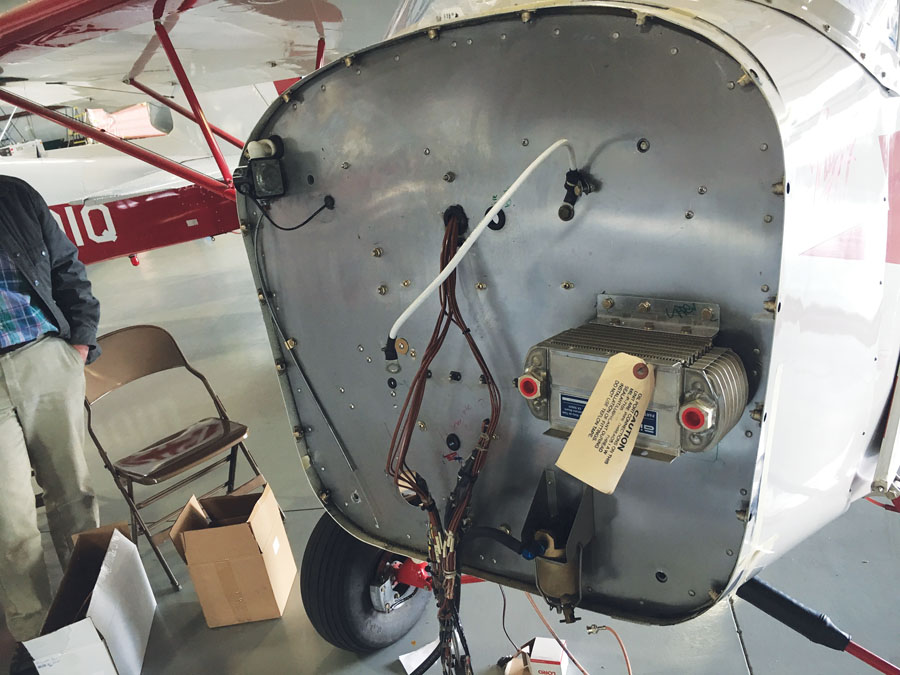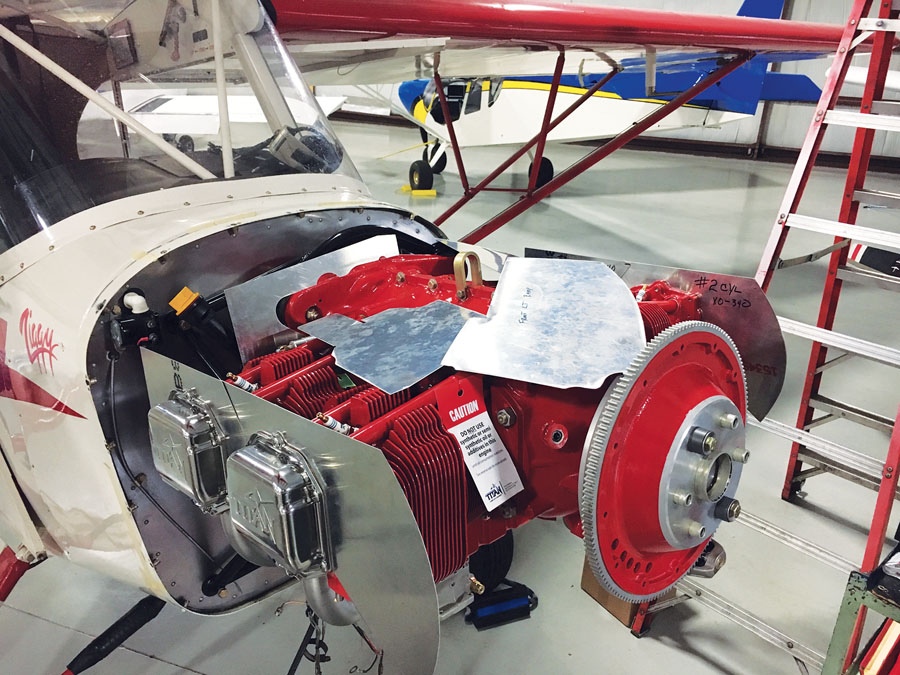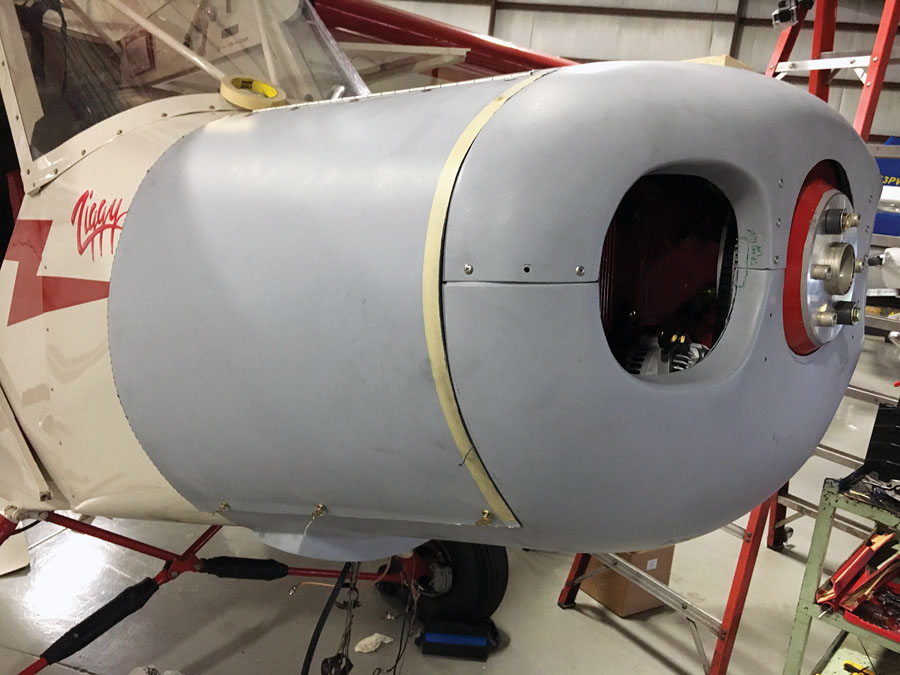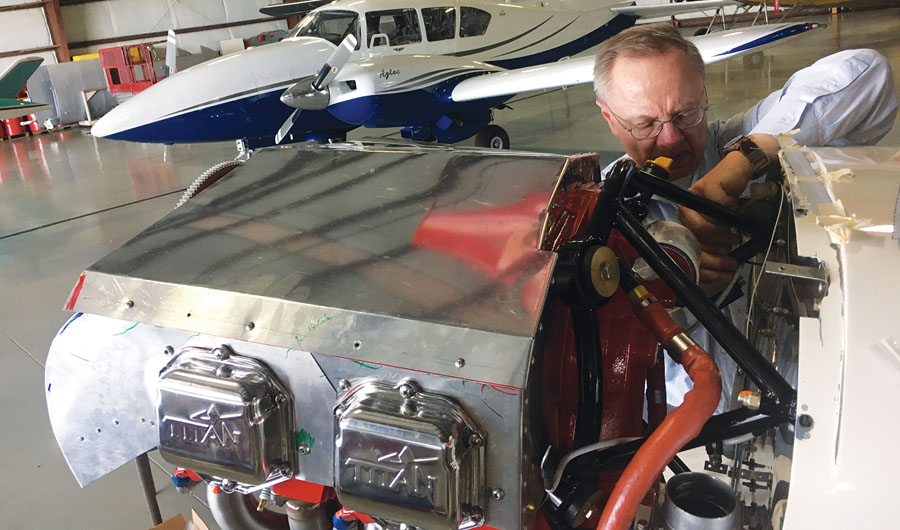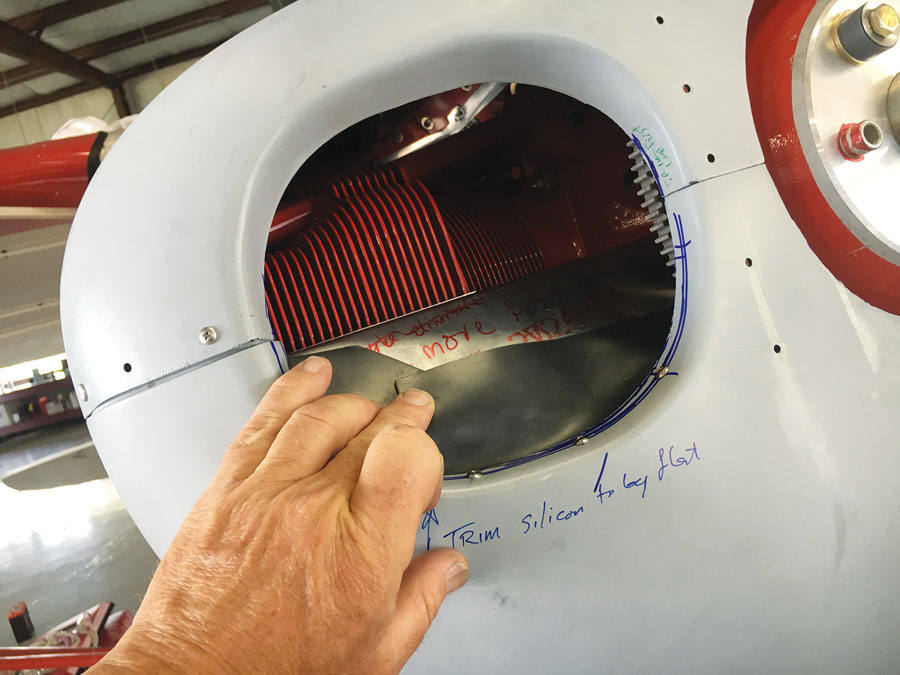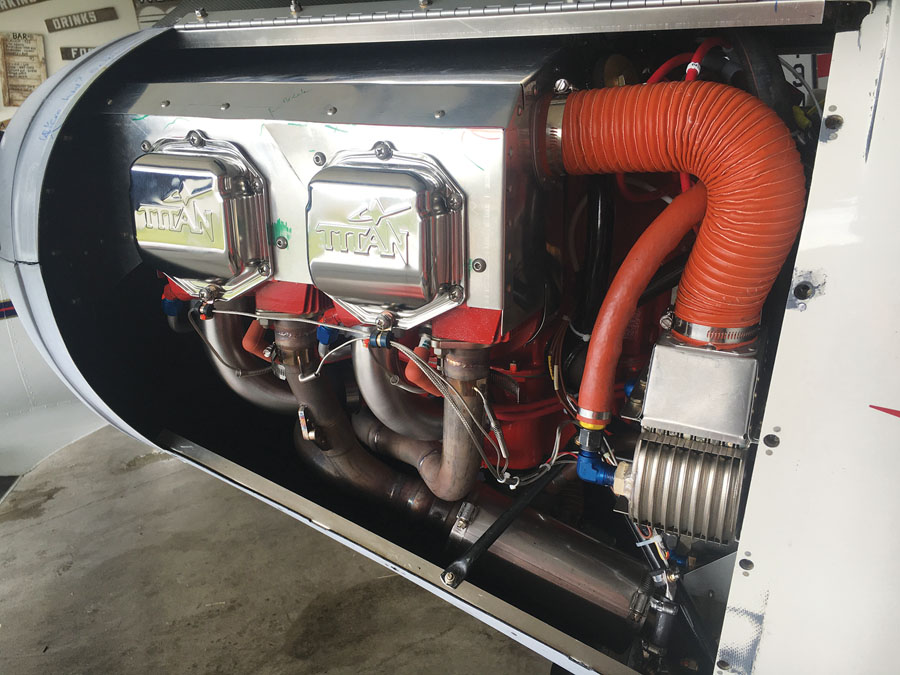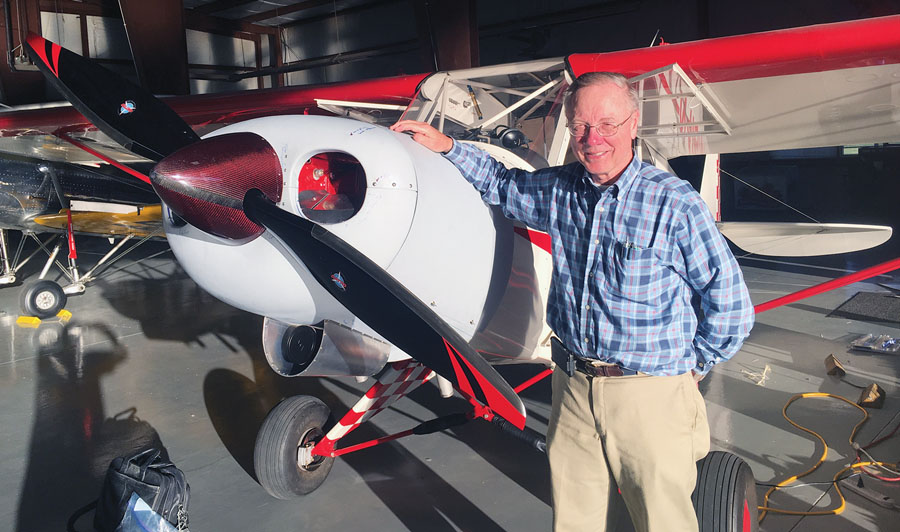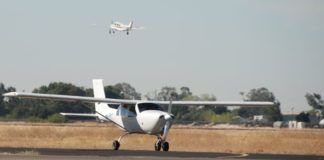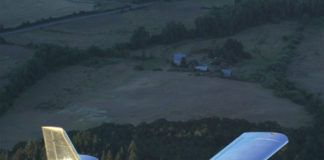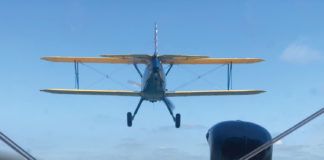It was at AirVenture 2017 that discussions about an engine swap on a Jabiru-powered Legend Cub took place between me, Darin Hart, owner of American Legend Aircraft Company, and aircraft builder/owner/operator Rand Siegfried. One year later, I followed up with Rand about the Cub, nicknamed Ziggy, and its 180-hp Titan installation. His reply: “Fantastic! Runs wonderfully, performs amazingly. Only thing wrong is that it’s still in Illinois. We have been moving and didn’t have a hangar out here. Planning on some backcountry work next season, stay tuned!”
Although they were pretty sure it would work, before the installation in Ziggy, Legend had never actually mated a Titan engine to a Cub with a Jabiru firewall and boot cowl.
Rand built the Legend Cub at the company’s facilities in Sulphur Springs, Texas, back in 2008 with his daughter McKinley. They took part in the factory’s KwikBild program. While a gift for McKinley’s 16th birthday, Ziggy has been flown by many members of the Siegfried flying family.
I was curious of the whereabouts of Ziggy and suggested a new photo shoot with its plumped-up engine cowling. The Titan engine is a derivative of the Lycoming O-360. Its four flat-set cylinders deliver an additional 60 horsepower over the formerly installed, and narrower, 6-cylinder Jabiru block.
After stripping the firewall of all components from the Jabiru installation, the new oil cooler for the Titan engine was installed.
Rand provided an insightful synopsis of the engine swap effort. “At Oshkosh a while ago, Darin told me that I’d love the performance of the Titan in a Legend. ‘It is spectacular,’ he said. Our Jabiru-powered kitbuilt Legend, Ziggy, was ready for a change, so I called to ask if we could buy a full firewall forward kit. The answer was something like this: ‘Well we don’t really have a kit, but we could probably make up some parts for you, but you’ll be doing a lot.’
“During a subsequent call, Darin was obviously thinking as he went along. Legend had never mated their Titan cowling to the Jabiru boot cowl and firewall, so although he didn’t see any reason it wouldn’t fit, there could be some mating issues and building to do as the boot cowl and firewall are a different shape. He then thought about the elevator, more specifically that they have always had a balanced Super Cub style horizontal stabilizer mounted with the Titan, and cautioned there might be some issues there. We agreed that since Ziggy is experimental and as long as I was aware, the evaluation flights should be fine. If there was an issue, I could do something then.”
Mindful that the Siegfrieds had been more than pleased with their amateur-built Legend Cub for many years, the need for speed, in a metaphorical sense, was but one of the reasons a change was necessary. A Cub’s wing will only go so fast, but the excess power of the Titan is stunning on takeoffs. The gentle nature of the Cub and its balanced flying surfaces provide pleasantly slow approaches and landings.
Rand continued in detail on the project: “A complicating factor for me was that the aircraft was located in Oshkosh, I live in California, and we needed a new engine prior to Ziggy flying. We dismissed dismantling her and trucking as she has a beautiful Legend paint job, and no matter how careful, there always seems to be some damage doing this. My dad, Old Bob, mentioned that they used to pull the prop off of Cubs, attach a tow hook, and tow them with another Cub. This sounded like a grand adventure with my family, especially as we are all glider rated and have worked as tow pilots. I also found an Oshkosh hangar that was available to work in, and being that I have been involved with the EAA on a volunteer basis for over 20 years, I know a lot of local folks who volunteered to support the effort with tools, etc. Practicality won out, and we decided to do the swap in Oshkosh.
“First, we had to gather the material from Legend and other vendors. The guys at Legend put together most of what we needed for a firewall forward install. At that time the Titan was a new installation for Legend. They were still improving something with each new install, and Ziggy had the Jabiru firewall/boot cowl to complicate the effort. It worked out that I could swing by Sulphur Springs, Texas, to pick up the ‘kit.’ There, I was able to review and photograph some existing installations and, more importantly, talk to the folks who were developing the installation. This proved to be well worth any additional expense as I am sure that it shaved a bunch of time off the install.
The completed baffles. An aluminum top was added to form a plenum. That’s Bob Siegfried installing components on the firewall.
“The kit consisted of an engine mount, untrimmed carbon cowling pieces, an exhaust system, hardware, control cables, etc., and some roughed-out aluminum for the baffling and plenum. I purchased the Titan engine and Catto propeller separately as Legend could not get any better price.”
Family Fun
As I’ve mentioned, the Siegfrieds are a family of flyers. Their presence at AirVenture Oshkosh is a longstanding annual event. In 2018, while attempting to track down Rand for more on the story, he was sailing to Nuku Hiva in the middle of the Pacific with his son. Then, back in the U.S., I caught him trailering to Wyoming for hiking and later making multiple flights to Wisconsin in preparation for the Oshkosh family gathering.
Rand filled in with more details from a year prior: “Once we got to Oshkosh with the Legend package, it was time to strip Ziggy of everything firewall forward. By the end of the day, we were bolting on the engine mount. It felt good to be moving forward with the new engine. My brother Bob had recently retired and was able to take the time to be up there and help. It would have taken much longer without him.
“We spent some time trying to get the engine in just the right place with an engine hoist, but in the end we were able to lift the 250-pound engine into its final position. Here is where patience really helps as you don’t want to force anything, but at times you have to push pretty hard. I was glad to have Bob helping as he never pushed to get it done, and rushing may have led to tweaking something wrong. Once the engine was in final position, then came positioning and mounting the cowl.
“Here is where we got to put the ‘Experimental’ into the Amateur-Built category as this engine cowling had never been mated with this firewall and boot cowling. A trip to Harbor Freight (one of many) yielded a multitude of clamps. The carbon fiber cowl has the nose bowl molded in and is split top and bottom with two large side doors, la Super Cub. I drilled and mounted the top and bottom halves together and started laying them on the engine. It felt good to see it looking like an airplane, but daunting as I had to get it straight to have it look right in the end. I started with the prop shaft and centered the nose bowl on and behind the propeller flange. Clamping temporary bars onto the engine/flange helped keep the nose bowl in place.
“Next came fitting the aft edge to the existing boot cowl, again with clamps and temporary stand-offs. I spent plenty of time measuring closely and then taking several steps back to review how it looked visually and making small adjustments. When I thought it was right, I took a coffee break and bothered some of the EAA mechanics with questions about their projects. When I returned, I did the same process all over again. Once I was satisfied, I grabbed my roll of painter’s tape and applied it edge to edge and then cut along the edge of the tape. This proved to be a fast and easy way to get a straight edge where I wanted it.
“Next came the mounting. After making up four small brackets, I clamped them onto the cowling and marked where they landed on the firewall. Soon we had the cowling mounted and were ready to position the doors. I clamped them on and used the tape to lay out the first edge where the hinge would go on the top. After making that cut and mounting the hinge, the rest of the trimming went well. The only trick left was to position the quarter-turn fasteners along the bottom. I was able to mount the receptacles where I wanted them, close the door, and use a pick to transfer the position to the door. None of this was hard, but I took my time so that it came out looking right.
Brother Bob poses with Ziggy before the first engine start. Note the red carbon spinner and Catto custom prop.
“My brother Bob was busy researching the electrical system differences, especially what would be required to support the new Light Speed Engineering electronic ignition. I did pull him away many times to take a look at the cowl fit. There was a good bit of rewiring required to support the change from the Jabiru electrical system to the more conventional system used with the Titan. The installation of the electronic ignition system was well documented, but there were a number of new components to find places for and some choices to be made to minimize any potential single-point failure modes. A few calls to Light Speed quickly addressed the questions that we had. I am very glad that Bob was there to work through this as he was better suited to it than I.
“The ignition power and control boxes were all to be mounted in the cockpit area, along with additional circuit breakers, switches, and indicator lights. Bob was able to do all that while I continued in the engine compartment without us getting in each other’s way. Between the ignition and engine installs, daily shipments were arriving from McMaster-Carr, Aircraft Spruce, and other suppliers.”
Figuring Out the Baffles
The engine baffles were the next project Rand tackled. There were several flat pieces that were blanked out from Legend, and he spent some time piecing them onto the engine to figure out where they fit. “The Legend guys really wanted me to truck Ziggy to their factory,” said Rand. “They told me they would have raw pieces, not a kit, and no documentation. As it turned out, this was a fun part of the project, kind of like a puzzle but made much easier by the photos I took of aircraft at Legend. Soon I had the blanks figured out and rough dimensions of what aluminum I would need to complete the project.”
Luckily, Rand had access to brakes, a shear, and even a roller for the cylinder baffles. Once started, the work went surprisingly fast. “I was able to squeeze all of the rivets by thinking through the sequence of setting them and having access to a very deep squeezer,” he explained. “What slowed me down were the parts I had to design for the front of the cowl that directed air from the cowl openings into the plenum. This required figuring out how to support the pieces and many trial fits. I had to remove the cowl to get everything in and out, so it was not fast. In the end, I think I got a pretty good fit, and the silicon baffle material has laid down well without getting ‘punched through’ by the air pressure in flight.
“With the cowl fit and the baffles in place, it seemed like we would be flying in no time. As it turned out, we still had all those little things like fuel lines, control cables, oil cooler, engine monitoring probes, electrical, and ignition to finish. All of this took a good bit of head scratching as everything was different than the Jabiru. Bob was busy wiring the new ignition when my other brother Rick headed up for some EAA Warbird meetings and had some free time. We put him on the job of mounting the ignition power units in the cabin.
“During this time, the EAA’s Ford Tri-Motor crew was doing their training in Oshkosh. Since we had beer, they all came over after meetings and had a look. We were deep into routing the throttle cable, which was not obvious (made more confusing with Jabiru battery placement, etc.). As you might imagine, there were many opinions on how to do this, some emphatic suggestions, and finally the one and only correct conclusion, marked on the firewall with a Sharpie. I listened intently, absorbed the knowledge, and in the morning did just what I was going to do before this hops-fueled design session. It was great fun, and all had good ideas and experience to learn from. As it turned out, I ended up rerouting the cable later after seeing a newer Legend install at Oshkosh. The ‘turns’ in the cable are now in the engine compartment instead of the cabin, which is much cleaner and something none of us suggested that evening.
“The FAA approval was straightforward. I very carefully read my operations specifications, and after the third reading I realized that a major change required me to submit an updated ops spec to the FAA. With that completed, we were ready to move on.
“By plugging away at one system hook-up at a time, these many tasks were soon done, and it was time to fire up the engine. We couldn’t believe how quickly it made great airplane sounds with that hot spark from the Light Speed ignition. We had decided not to install a priming system and that has proved to be a good call with this ignition as the engine starts immediately.”
Time to Fly
After ground runs and checks, Ziggy was ready to fly. According to Rand, “The acceleration with 180 horses and the Catto prop was really something else, followed by amazing climb. The weight and balance ended up about 100 pounds heavier and at the forward limit. I mounted a tool kit in the tail and have small brakes to keep the nose off the ground. The fuel flow at full power seemed less than what you would expect out of 180 hp, which led to higher cylinder temps than we wanted at high power settings. Darin at Legend finally figured out that the engine from Titan was spec’d with a size smaller carburetor than needed. After the carb swap, the installation has worked excellently.”
While an engine swap may be one of the most complex of all aircraft upgrade projects, it’s more common than one might think. The classic Cub is commonly recognized by its emphatically harmonious sounding Continental engine. Alternatives were tried, including Franklin, Lycoming, and a 3-cylinder radial Lenape. The Legend Cub has traditionally sported a 100-hp Continental, and it’s been fitted with 115-hp Lycomings, 120-hp Jabirus, and now the 180-hp Titan. Bigger is better seems to be the operative.
Taxiing Ziggy for the first test flight at KOSH. According to Rand, “The acceleration with 180 horses and the Catto prop was really something else, followed by amazing climb.”
Rand summarized his delight with the changeover: “Ziggy, with the small J3-size tail and large engine, flies just fine. She is controllable throughout. Although I do feel I’d like a little more nose-up control authority, I have flown other aircraft with less. I would like some more up trim and intend to change the incidence of the elevator when she is back in California.
“After flying her 30+ hours with some cross country, all I can say is that Ziggy is great fun again. I flew from Illinois to Rogers, Arkansas, and then on to Alpine, Wyoming. During that trip, it seems I was getting at least 10 mph more true airspeed on the same fuel compared to the Jabiru. Having a mixture control sure helps, as does the Catto prop. Next spring, I’ll bring her back to California and do the final finish work and paint on the cowl so she is pretty again.
“As I think back to the install, I feel it went very well. One thing I might do differently is figure out how to route the mixture control to the left side. Since the Jabiru did not have one, we had to install one. The most straightforward installation was on the right side of the panel. I find myself hitting it with my feet as I swing my legs into the cockpit (60-year-old legs don’t bend the same as they used to).
“My takeaways are those that working on aircraft keep reminding you: Take the time at the beginning to really think things through. It helps speed up the project. Having my brother Bob there to do the electrical install was invaluable. It is good to recruit help to fill in where your skills are weaker. In conclusion, this was a fun project that ended up taking two trips, each a bit more than a week of long days. Not being at home, we were able to spend full time on the project with few distractions. There were times when I missed some tools we have at home, but the support from the folks at Oshkosh was fantastic. Now I can’t wait to fly this beast—the performance is spectacular!”



